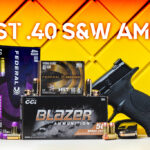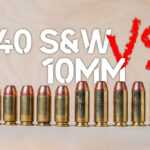
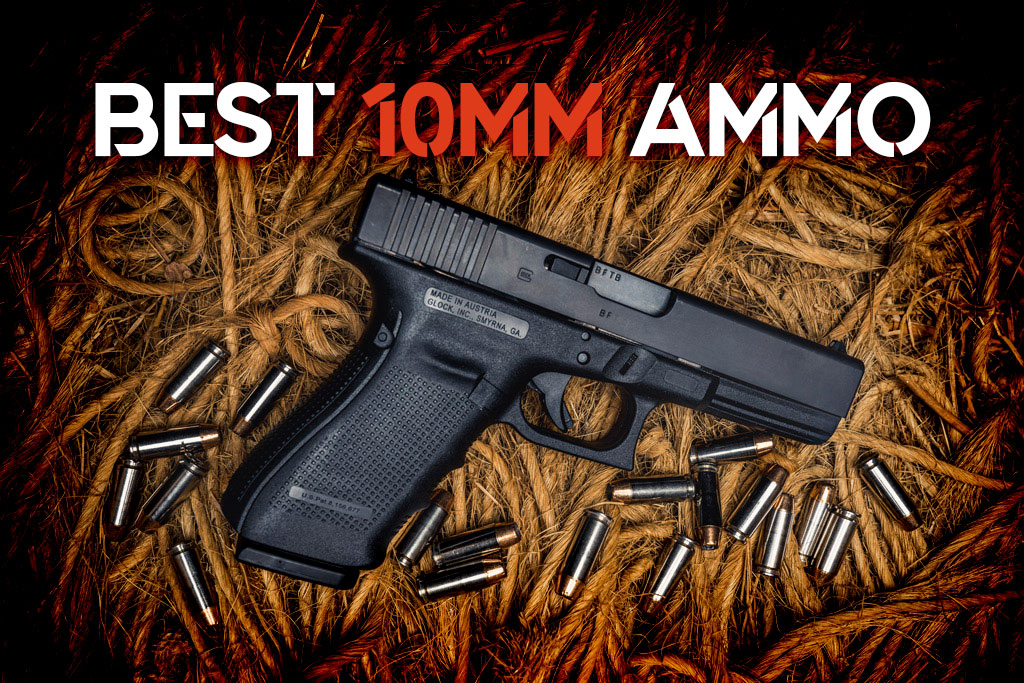
While it’s not exactly a “Big Bore” caliber, 10mm Automatic ammo packs a punch well above its weight class. It performs every bit like a Big Bore magnum, thumping anything unlucky enough to be on the receiving end with great malice. 10mm was designed to be a hot load caliber, created to hit targets with a disruptive force with a flat trajectory. So, what makes the best 10mm ammo? We’ll get into all that and more in the article below.
10mm auto quickly became the standard duty caliber of the FBI in the 1980s. They adopted the heavy caliber following their infamous and disastrous Miami shootout with .38 caliber revolvers. After an investigation into the shootout, detectives found the dated service weapons failed to incapacitate the suspects, resulting in the death of two agents. Perhaps the only problem with the 10mm cartridge is that it worked and penetrated targets a little too well. The FBI phased it out of standard service almost as quickly as it was introduced due to “excessive recoil.”
Best 10mm Ammo
When compiling our list of the best 10mm ammo, we considered availability, performance, and reliability. With that in mind, our list of the best 10mm ammo includes:
Best 10mm Range Training Ammo
Federal American Eagle 10mm Auto 180 Grain FMJ
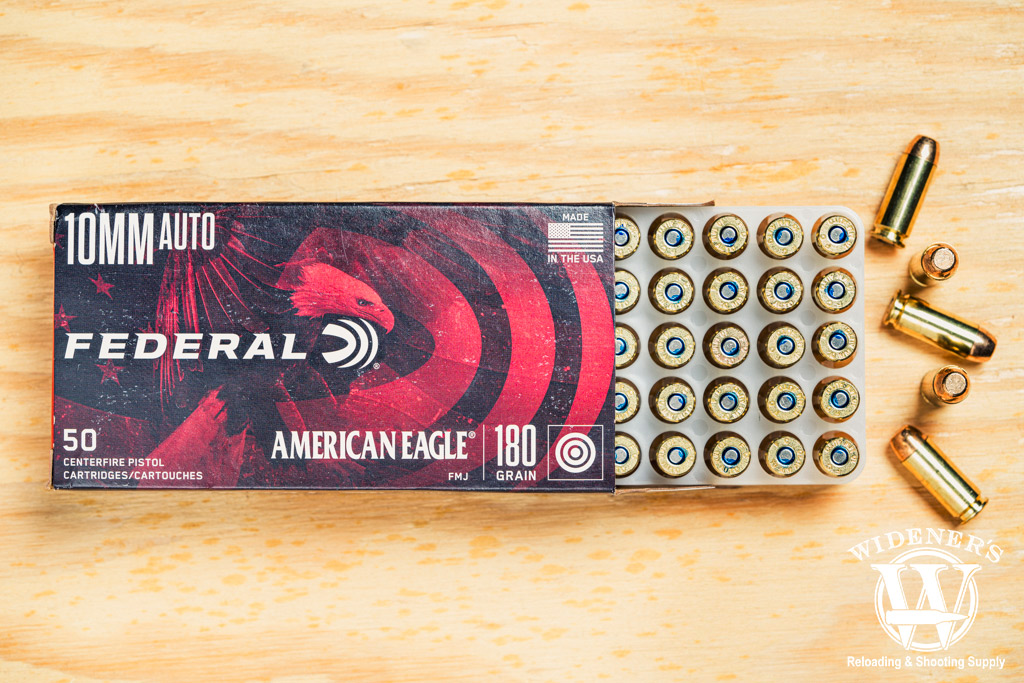
You don’t need a sleeveless jean jacket and a mullet to appreciate the 10mm Federal American Eagle performance.
This popular American-made ammo from Federal enjoys a good reputation as a quality training round. Their 180gr FMJ offering is proof positive that this caliber is a thumper, regardless of the bullet being pushed. It exits a 5” barrel at 1,030 fps with 424 ft/lbs of energy. It’s a great option for training and plinking at the range while improving your skills.
| Caliber | Bullet Type | Bullet Weight | Velocity (Muzzle) | Energy (Muzzle) | 25 Yards (Velocity/Energy) | 50 Yards (Velocity/Energy) | 100 Yards (Velocity/Energy) |
|---|---|---|---|---|---|---|---|
| 10mm | FMJ | 180gr | 1,030 FPS | 424 FT LBS | 998 FPS/398 FT LBS | 970 FPS/376 FT LBS | 921 FPS/339 FT LBS |
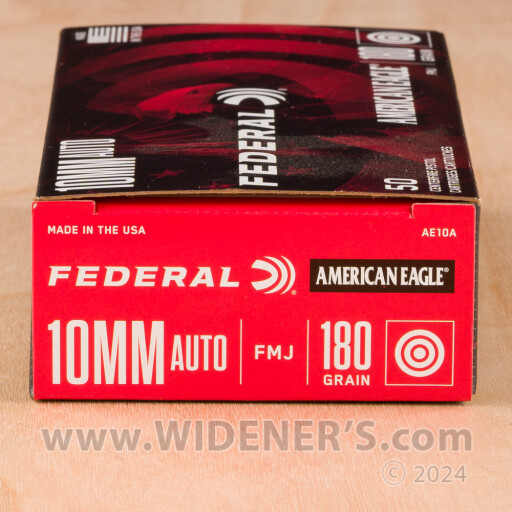
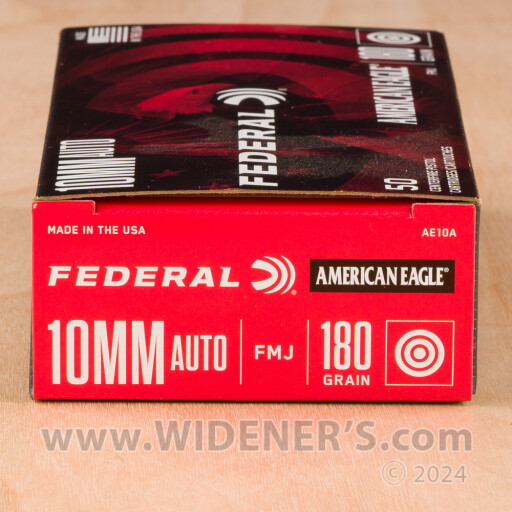
Remington UMC 10mm Auto 180 Grain MC
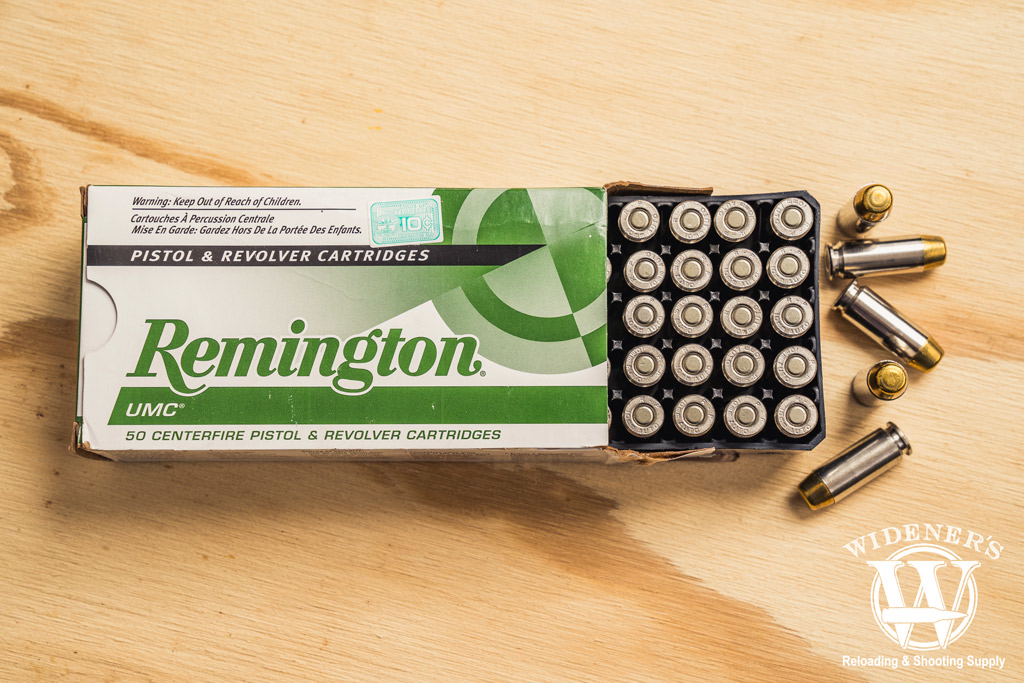
Remington 180gr 10mm ammo is a great choice for training at the range.
It’s tough to say exactly how Remington UMC 10mm stacks up to S&B 180gr FMJ, because the UMC ballistic chart states that a 4” barrel was used. That being said, UMC 180 gr ball ammo is nothing to laugh at, with a powerful velocity of 1,150fps and 528 ft/lbs. Limp-wristing this potent 180gr ammo on the range is not advised.
| Caliber | Bullet Type | Bullet Weight | Velocity (Muzzle) | Energy (Muzzle) | 25 Yards (Velocity/Energy) | 50 Yards (Velocity/Energy) | 100 Yards (Velocity/Energy) |
|---|---|---|---|---|---|---|---|
| 10mm | FMJ | 180gr | 1,150 FPS | 529 FT LBS | 1,103 FPS/486 FT LBS | 1,063 FPS/452 FT LBS | 999 FPS/399 FT LBS |
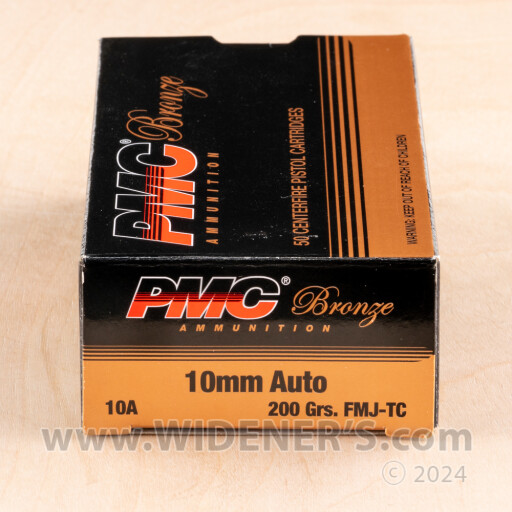
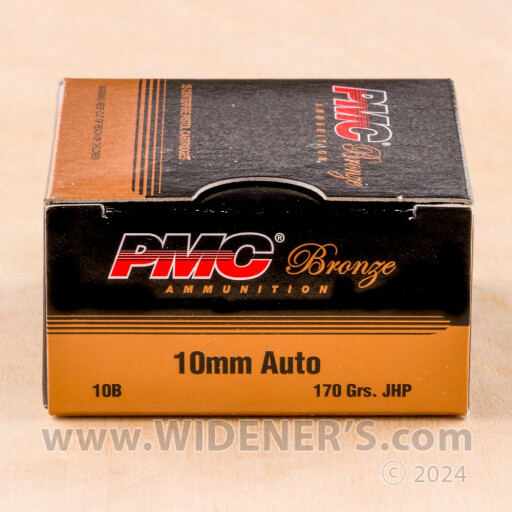
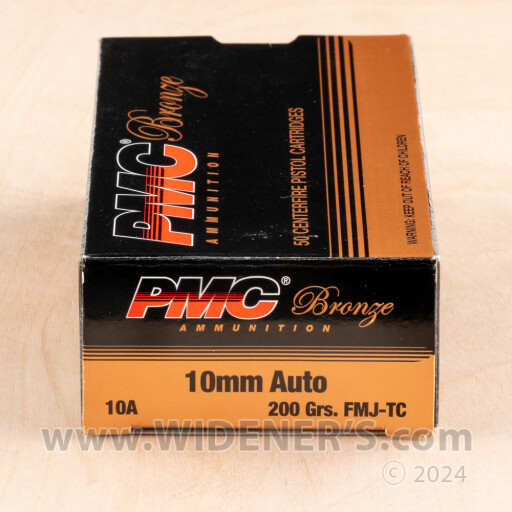
Best 10mm Self-Defense & Duty Ammo
Federal 10mm 180 Grain Hydra-Shok JHP
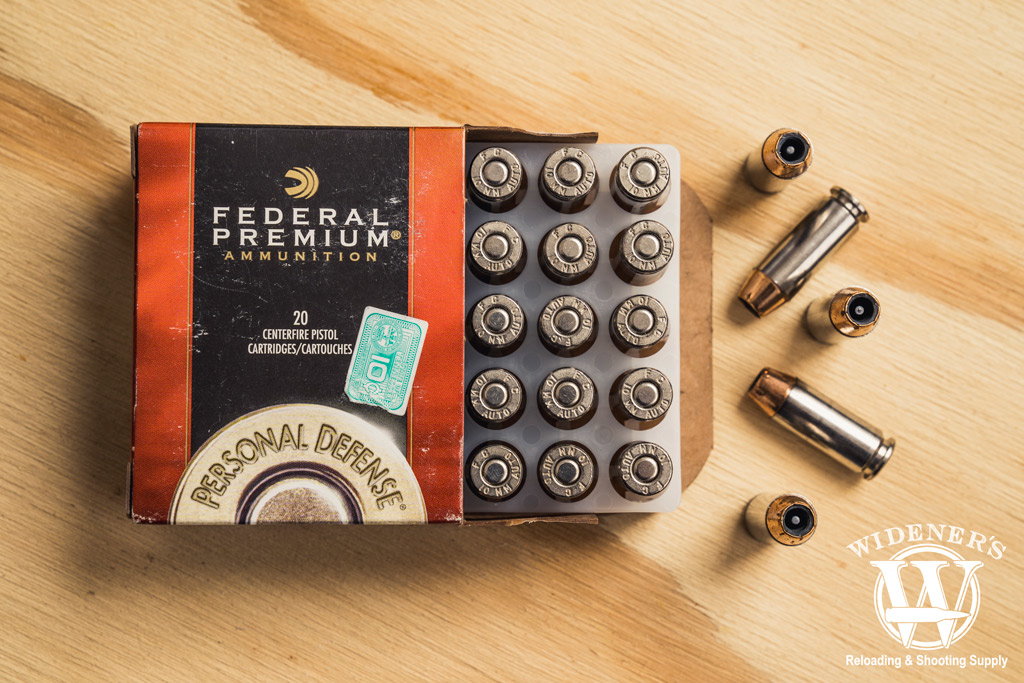
Federal has been making the popular Hydra-Shok line of ammunition since 1989.
The Hydra-Shok line of bullets continues to stand the test of time very well. Federal’s made the ammo for just shy of three decades now. Either the trusted Federal brand name sells it, or it sells because shooters know it works exactly as advertised. That being said, the 180gr Hydra-Shok is a JHP, intended to expand to avoid over penetration in close quarters engagement.
It is powered like a comparable .40 S&W round at 1,030 fps and 424 ft/lbs at the muzzle. So why not just go with a .40 S&W? I’d rather have a pistol capable of far more energy, but not always be forced to use it. There are other 10mm bullet weights available, making it a good option to get more out of your proverbial hand cannon.
| Caliber | Bullet Type | Bullet Weight | Velocity (Muzzle) | Energy (Muzzle) | 25 Yards (Velocity/Energy) | 50 Yards (Velocity/Energy) | 100 Yards (Velocity/Energy) |
|---|---|---|---|---|---|---|---|
| 10mm | JHP | 180gr | 1,030 FPS | 424 FT LBS | 1,002 FPS/401 FT LBS | 924 FPS/341 FT LBS | 845 FPS/285 FT LBS |
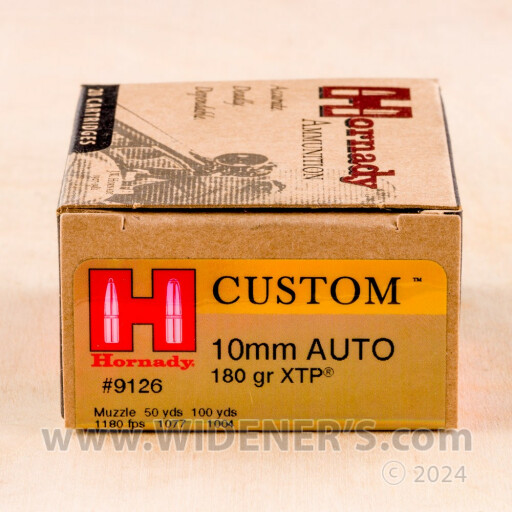
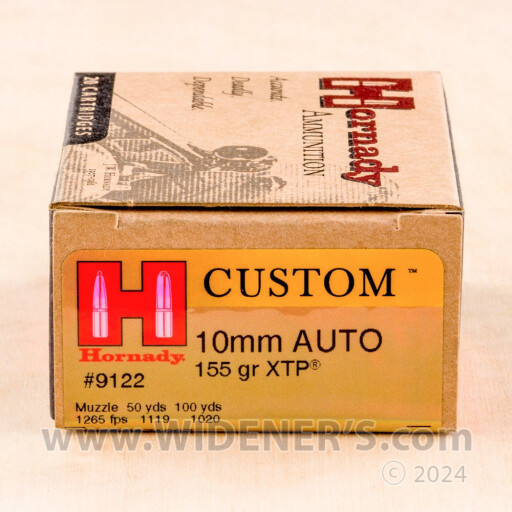
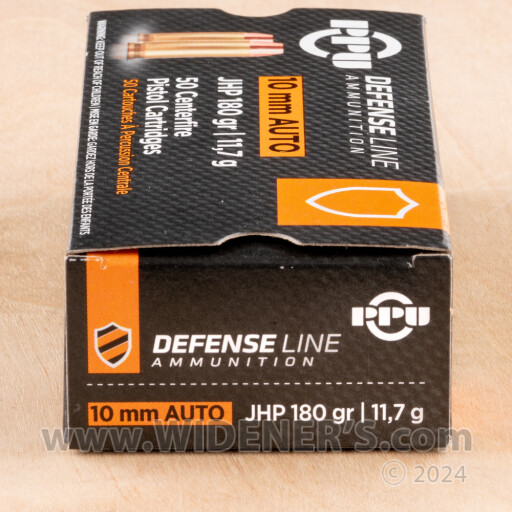
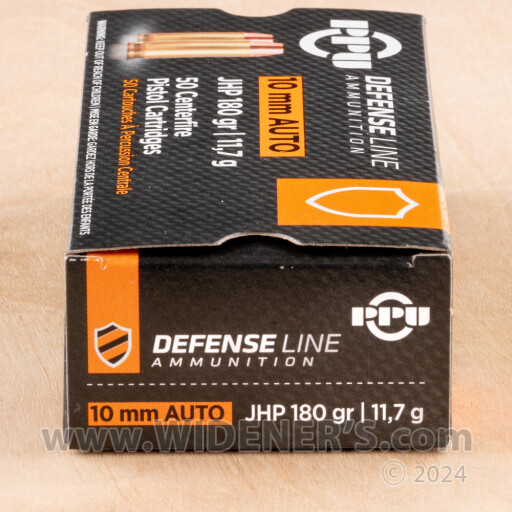
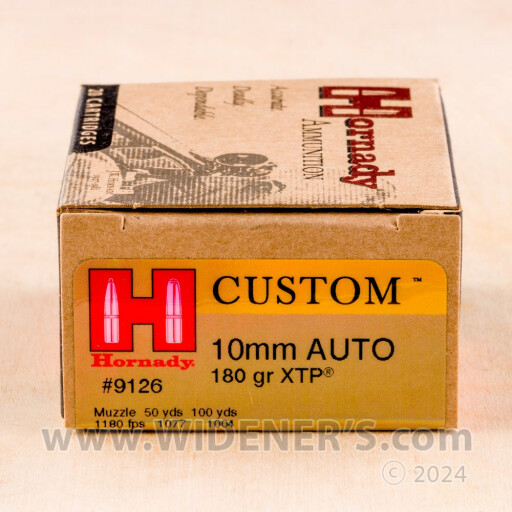

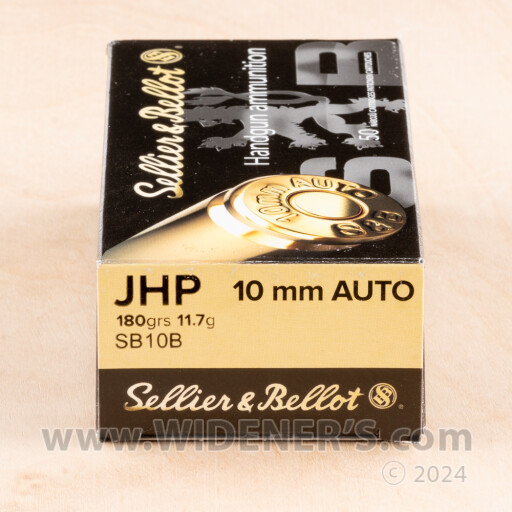
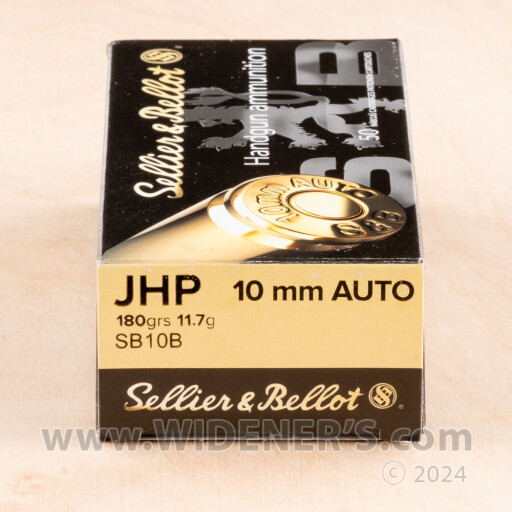

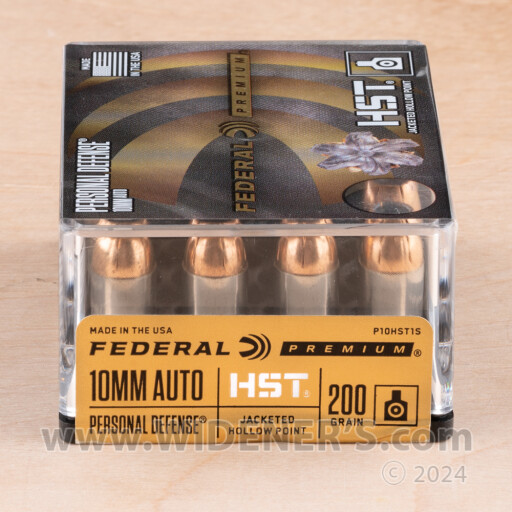

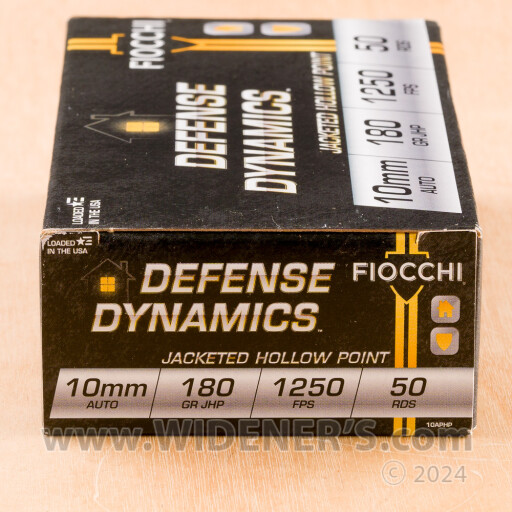
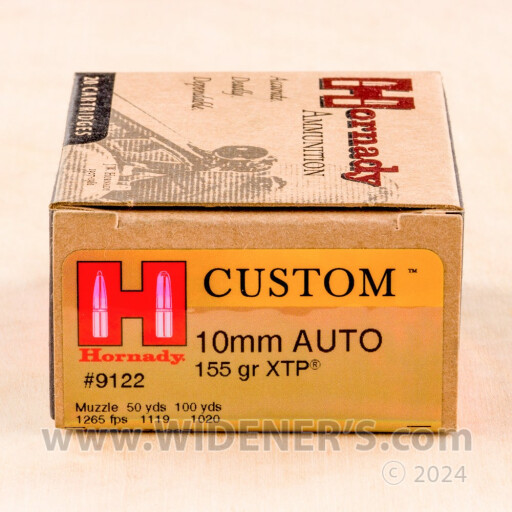

Hornady Critical Duty 10mm Auto 175 Grain Flexlock
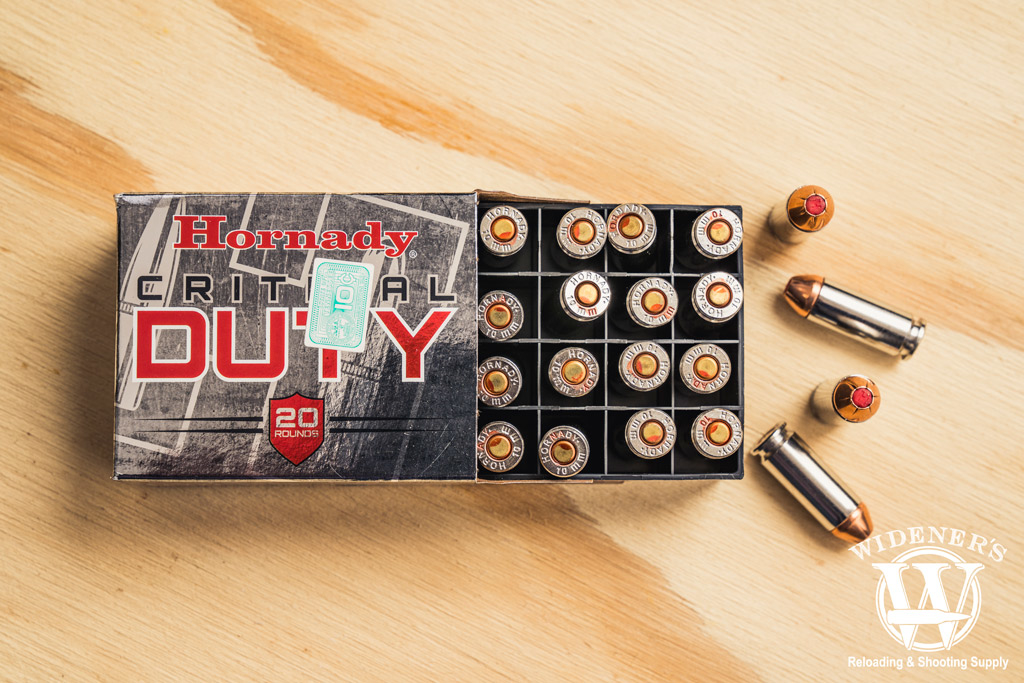
Hornady’s Critical Duty line in 10mm is focused on performance and penetration.
This has been the author’s CCL load of choice for over six years now, albeit not in the sledgehammer caliber of 10mm. Hornady opts for a less potent offering in their Critical Duty 10mm. Let’s face it, the full-power 10mm loads are just too hot for most close combat duty situations. If you’re in bear country, supersize that Ten. But biped predators normally aren’t nearly as tough as big, hungry predators in the backcountry.
Critical Duty Flexlock is designed as an effective JHP with a polymer plug in the cavity. This allows it to penetrate light vehicle skin and glass without overly deforming the bullet. This allows shooters to fire through glass and vehicle skins more effectively in life-or-death situations. The 175 gr load shows 523 ft/lbs at 1,160fps from the muzzle of a 5” barrel.
| Caliber | Bullet Type | Bullet Weight | Velocity (Muzzle) | Energy (Muzzle) | 25 Yards (Velocity/Energy) | 50 Yards (Velocity/Energy) | 100 Yards (Velocity/Energy) |
|---|---|---|---|---|---|---|---|
| 10mm | JHP | 175gr | 1,160 FPS | 523 FT LBS | 1,134 FPS/500 FT LBS | 1,061 FPS/437 FT LBS | 990 FPS/381 FT LBS |



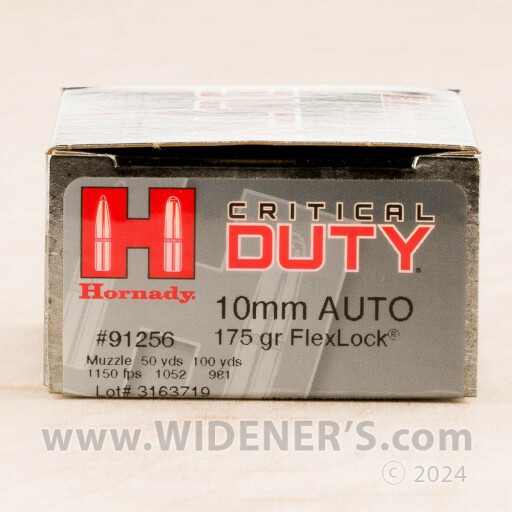

10mm Ballistics
In terms of raw ballistics, there is not much of a comparison between the respective calibers. Looking over to Hornady, at the XTP ® line of ammunition. The 180gr. XTP ® in 10mm boasts 1,275 fps and a pounding 650 ft/lbs of energy at the muzzle. The .40 S&W firing the exact same bullet shows 950 fps and 361 ft/lbs, and a .45 ACP firing a light 185gr. XTP ® shows 970 fps and 386 ft/lbs at the muzzle. The hottest .45 ACP of the line is the +P, 200gr. XTP ® which produces 1,055fps and 494 ft/lbs.
If you step up to the lighter and hotter 155gr. XTP ® in 10mm, you find a blistering 1,410 feet per second with 684 ft/lbs of energy. The same bullet in .40 S&W produces just 1,180 feet per second and 479 ft/lbs. So, the 10mm offering is 16% faster, but most significantly has 30% more energy with the same projectile. The 180gr bullet in 10mm is 17% faster than the hottest .45 ACP XTP ® available (+P, 200gr), with 24% more energy.
Cartridge Specs
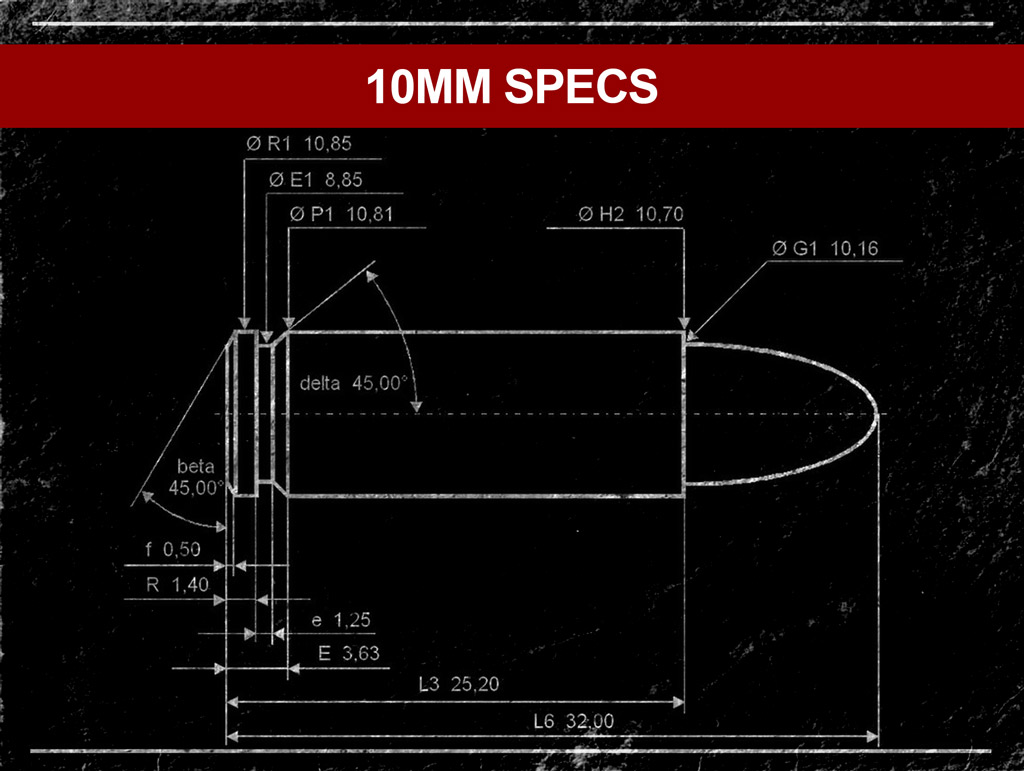
The 10mm cartridge has more power than the 9mm round, but it comes at the cost of manageable recoil for most users.
10mm offers powerful performance with above-average handgun ballistics. It typically comes in bullet weights ranging from 77 to 220 grains, offering a good mix of velocity and energy. It’s designed to be used in striker-fire semi-auto pistols, however, it’s often found in revolvers, and pistol-caliber carbine guns as well. In terms of size, it’s larger than a 9mm bullet and has an effective range of around 100 yards.
| Cartridge Specs | 10mm |
|---|---|
| Parent Casing | .30 Remington |
| Bullet Diameter | .4005″ |
| Neck Diameter | .423″ |
| Base Diameter | .425″ |
| Case Length | .992″ |
| Overall Length | 1.260″ |
| Grain Weight | 77-220gr |
| Max Pressure (SAMMI) | 37,500 PSI |
What’s The Difference? 9mm VS 10mm VS .45 ACP
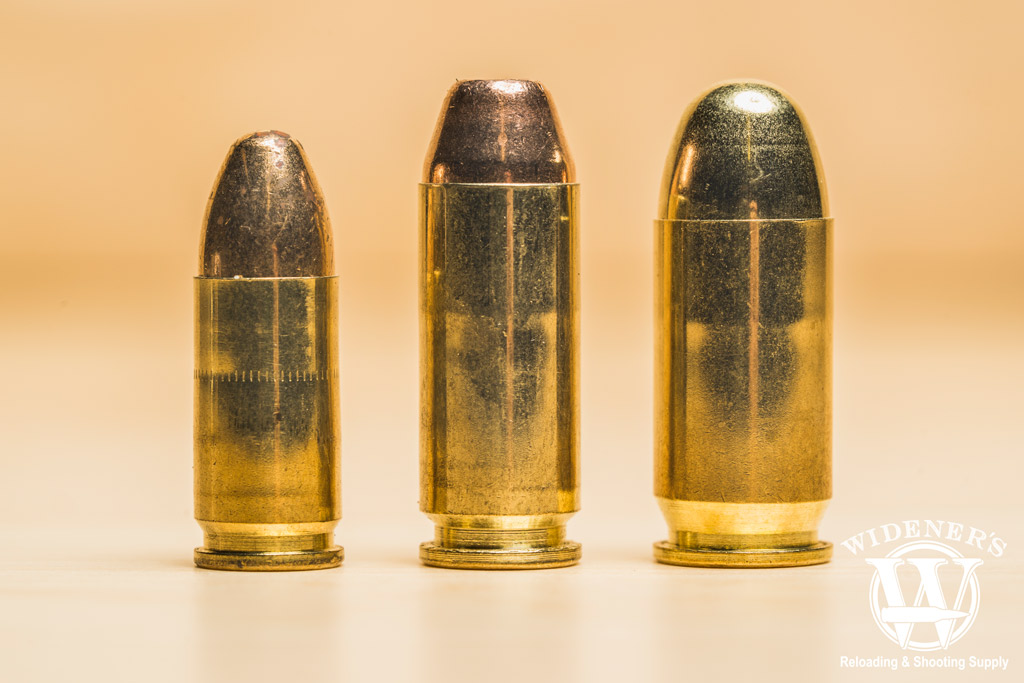
From left to right: 9mm, 10mm, and .45 ACP ammo for comparison.
Right off the bat, the 10mm bullet is larger and heavier than the 9mm. On average, the 10mm has better penetration and velocity than the 9mm, and .45 ACP, despite being similar in size. The larger casing of the 10mm holds more powder than the 9mm, or the .45 ACP, allowing the bullet to keep a flatter trajectory while in flight. Recoil with a 9mm pistol is manageable for most gun owners. However, recoil with a 10mm, or .45 ACP may be difficult to manage for smaller framed individuals. In terms of pricing, 9mm is the cheapest option, with 10mm and .45 ACP being more expensive.
While not exactly ‘rare’, 10mm isn’t exactly quite common, either. At least not to the same extent as the .40 S&W and .45 ACP. The selection of firearms chambered in 10mm is limited. Because of the length of the 10mm case and the intense pressure of the caliber, it must be used on existing large-frame handgun platforms. Those firearms have historically been designed to use .45 ACP ammunition.
History Of The 10mm Cartridge
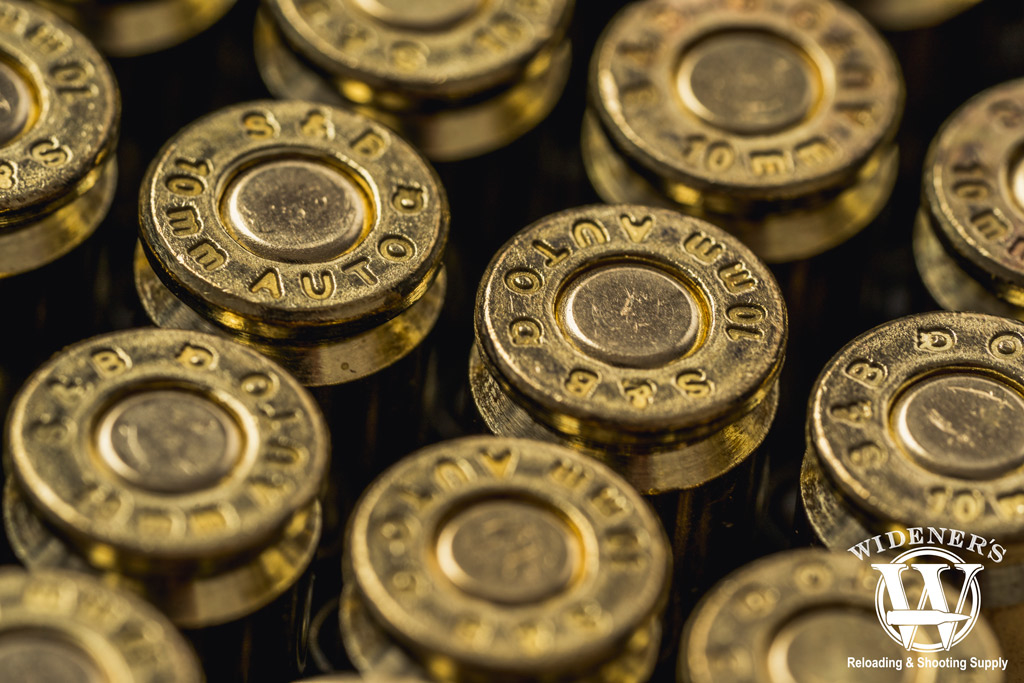
The 10mm platform has seen a rise in popularity due to an increase in handgun models available on the market.
The Jeff Cooper-designed 10mm round was meant to be a performance cartridge. It’s more powerful than 9mm with improved ballistics over the .45 ACP. In fact, the 10mm is almost ideal for competition match shooting in handguns because it shoots so flat. It hits somewhere in between the .357 Magnum and the .41 Remington Magnum (according to Hornady, a little closer to the .357). However, it has a relatively compact case that can be chambered in a standard-sized pistol without prohibitive redesign or organic design. It has been used widely in easy-to-find revolvers designed by Smith & Wesson and Ruger.
The Bren Ten
The cartridge was originally requested for a one-off pistol design, the Bren Ten by Dornaus & Dixon Enterprises, a design that was essentially cloned from the CZ-75. While generally considered a quality firearm, Dornaus & Dixon isn’t exactly a household name. The pistol never really took off beyond a cult following stemming from the pistol’s flashy appearance in the TV show Miami Vice.
After testing and careful consideration, the 10mm round was formally adopted by the FBI in 1990 for use in the Smith & Wesson 1076 semi-automatic pistol. This was short-lived though, as the Glock 22 and 23 were adopted only seven years later in the .40 S&W. It is interesting to note, though, that the FBI still uses H&K MP10 in their special response teams.
Which Pistol 10mm Pistol Should You Buy?
Originally, this comparison was between the 1911 style and Glocks, two distinctly different platforms. With the addition of a 10mm to the Springfield Armory XDm lineup, it seems unfair not to include the newcomer. It’s sure to be mass-produced like the Glock and will surely be an affordable option, a characteristic of 10mm pistols which is in short supply.
There is not a right or wrong answer here; it depends on your wants, needs, purpose, and personal preferences. The single-stack 1911 design has a significantly lower capacity than the striker action pistols, with 8+1 to each Glock and Springfield 15+1.
The striker-fired polymer pistols are lighter; the 4.5” Springfield XDm weighs in at 31.2oz to the Ruger SR1911 Targets 40.4oz. But, there are a lot of purists out there who swear by the 1911, especially in the competition shooting world. This could be because of the infinite number of upgrades available to the 1911; where-as Glock is a Glock is a Glock.
True to form, Glock is the only manufacturer who currently manufactures a 10mm in anything less than full-size, the G29. So the boarish power of the 10mm is also available for the CCL crowd. As you can imagine, the G29 has significant recoil, so proceed at your own risk.
10mm Power Packing Performance
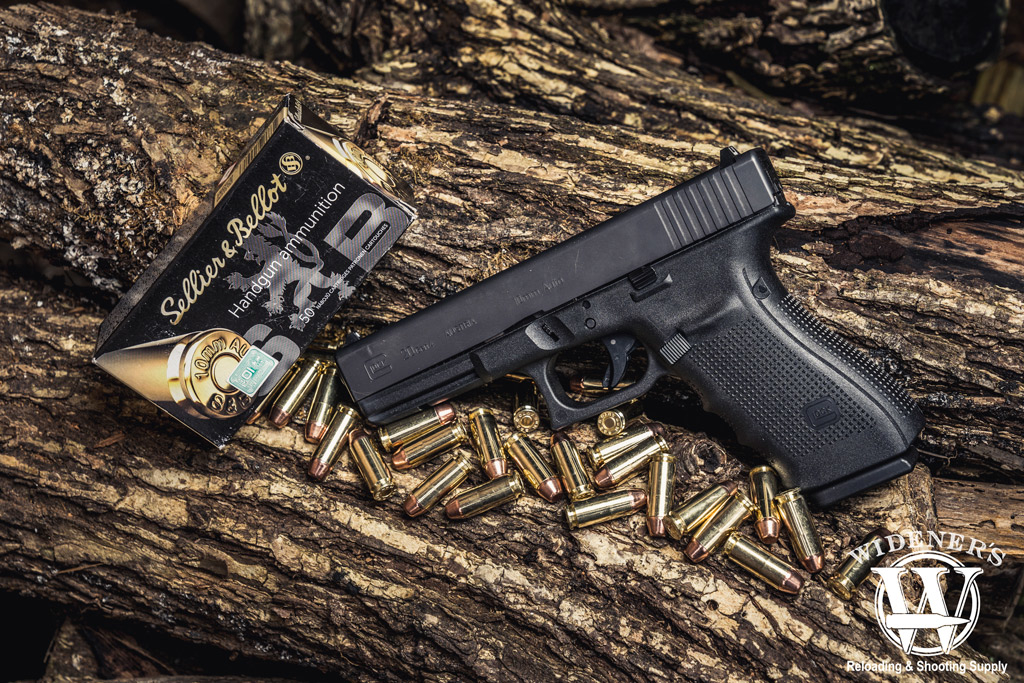
It’s hard to deny the power and performance of the 10mm cartridge.
The 10mm is a legitimate Big Bore contender in the handgun universe. It packs magnum wheel gun performance in a standard-size autoloader. Sadly, it’s performance comes at the cost of punishing recoil. It was enough to drive away a prized advocate for the caliber, the FBI.
The round would have been all but dead in the water had superlative shooters not taken notice of its eye-raising ballistics. The availability of Colt’s coveted 10mm Delta Elite pistol, plus surplus S&W service pistols flooding the market kept it afloat until mass-produced models came along. These factors proved to be just enough to keep the caliber from obscurity. Although the infamous recoil has kept it from the law enforcement popularity of its stumpy kin, the .40 S&W became more of a household name.
It’s hard to look at the 10mm and not see all the benefits the caliber offers to the educated shooter. The 10mm offers real magnum performance with nearly three times the capacity of a revolver. You get much quicker reload times and target acquisition, and the light trigger pull of a single-action pistol. Its power level can be brought down on par with a hot .40, or scaled up to eclipse the .357 Magnum. However you like it, the 10mm is an often underappreciated caliber which warrants you to give it at least a second look.


